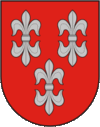Rumšiškės
| Rumšiškės | ||
|---|---|---|
| Town | ||
 |
||
|
||
| Location of Rumšiškės | ||
| Coordinates: 54°51′50″N 24°13′0″E / 54.86389°N 24.21667°ECoordinates: 54°51′50″N 24°13′0″E / 54.86389°N 24.21667°E | ||
| Country |
|
|
| Ethnographic region | Dzūkija | |
| County |
|
|
| Municipality | Kaišiadorys district municipality | |
| Eldership | Rumšiškės eldership | |
| Capital of | Rumšiškės eldership | |
| First mentioned | 1382 | |
| Population (2001) | ||
| • Total | 1,833 | |
| Time zone | EET (UTC+2) | |
| • Summer (DST) | EEST (UTC+3) | |
Rumšiškės (Yiddish: רומשישאָק, Rumshishok, Polish: Rumszyszki) is a Lithuanian town (population 1,700), situated 20 km (12 mi) east of Kaunas on the northern bank of Kaunas Reservoir. Southern part of the town (including the birthplace of Lithuanian poet Jonas Aistis) is now under the waters of the artificial lake. The 18th century St. Michael Archangel church of Rumšiškės (rebuilt in the 19th century) was saved and moved to its present place in 1958, when the reservoir was created.
Rumšiškės was first mentioned in the 14th century. In 1940–1941, a Soviet concentration camp was created in a nearby village of Pravieniškės. After 1941 the camp was used by the Nazis. All the member of the Jewish community were murdered by the Nazis and Lithuanian nationalists near Rumšiškės during World War II. [1] One of the most well-known Jews of this locale is Rabbi Haim, known best for the Jewish adaptation of allegory of the long spoons.
Kaunas Lagoon now lies in the place of the old Rumšiškės. The old town was flooded as a result of the construction of Kaunas hydroelectric power station, while the main objects – St. Michael the Archangel Church, its bell tower and the chapel that stands in the current Rumšiškės town cemetery – were moved.
Today, Rumšiškės is best known for its excellent open-air ethnographic museum (established in 1966 and opened in 1974), one of the largest in Europe.
The open-air museum is a unique and one of the largest open-air ethnographic museums in Europe. It has the biggest quantity of exhibits (90820 exhibits). The open-air museum in Rumšiškės displays the heritage of Lithuanian rural life in a vast collection of authentic resurrected buildings where the Lithuanian people lived and worked. The total area of 175 ha (432 acre) contains 140 buildings from the 18th–19th century with the restored original interiors and surroundings. This museum was established to help to preserve and research the former ways of living.
...
Wikipedia


